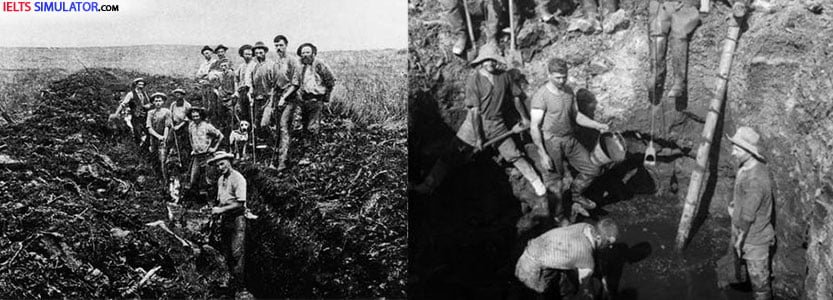IELTS READING – Working Time Regulations for Mobile Workers S1GT4

IELTS READING Working Time Regulations for Mobile Workers Reading Practice Test has 10 Questions..
These rules apply to drivers and crew of heavy goods vehicles or public service vehicles. The rules limit the amount of time that can be worked.
Those defined in the Regulations as being Q1 self-employed are currently not covered by the Regulations.
What are the limits?
• An Q2 average of 48 hours’ work per week.
• In any single week up to 60 hours can be worked so long as the 48-hour average is maintained.
• Night work is limited to 10 hours per night, unless there is a workforce Q3 agreement to work longer.
• Statutory annual leave and any sick leave and/or maternity/paternity leave counts as working time.
What counts as work?
In general, any activities performed in connection with the transport operation count as work, for example, driving, loading/unloading and those Q4 checks that are the responsibility of drivers, such as checking lights, brakes, etc. There are a number of periods of time that do not count as work, for example, travelling between home and your normal place of work, lunch or other breaks and periods of availability.
Periods of availability are periods of time during which the mobile worker is not required to remain at their workstation but is required to be available for work, the foreseeable duration of which is known about in advance, for example:
• Delays at a distribution centre.
• Reporting for work then being informed that no duties are to be undertaken for a specified period.
• Accompanying a vehicle being transported, for example by Q5 trains.
A period of availability can be taken at the workstation. Providing the worker has a reasonable amount of Q6 freedom (e.g. they can read and relax) for a known duration, this could satisfy the requirements of a period of availability.
Situations when a period of time should not be recorded as a period of availability:
• Hold-ups due to Q7 congestion, because the driver would be stopping and starting the vehicle.
• Frequently moving up within a queue (e.g. waiting within a queue to load or unload) every other minute.
Learn From Experienced Teacher Best IELTS Coaching Dehradun Best IELTS in Dehradun Uttarakhand GMS Road BEST coaching in Dehradun Apply for Class Courses Today Good Results.
![]()
8439000086
8439000087
7055710003
7055710004
IELTS Simulation 323 GMS Road, Near Ballupur Chowk, Dehradun, India
![]()
email: info at ieltsband7.com
Boost Your Score: Practice IELTS Online with IELTS Simulator Prepare for IELTS Effectively Using IELTS Simulator Ace the IELTS: Try Realistic Practice on IELTS Simulator IELTS Simulator: Online Practice to Improve Your IELTS Score Rocky Bay field trip listening practice test has 10 questions belongs to the Leisure & Entertainment subject. Prepare for IELTS IELTS Test International Experienced Teacher Best Training By CELTA Trainer. Best Results Easily Get Required Score IELTS Exam Dates Available, Small Batch Size with Flexible Time, Professional. Easily Get Required Score I am interested in IELTS Pass with Confidence, Dehradun Small Batch Size with Flexible Time, professional faculty. Learn From Experienced Teacher Best IELTS Coaching Dehradun Best IELTS in Dehradun Uttarakhand GMS Road BEST coaching in Dehradun Apply for Class Courses Today Good Results. Small Batch Size, Flexible Time and Professional IELTS Teacher Best IELTS coaching classes IDP certified British Council trained and CELTA certified experienced trainer. Easily Get Required Score Tel:8439000086 Tel:8439000087 Tel:7055710003 Tel:7055710004 Tel:7055710009
IELTS READING – BIG ROCK CLIMBING CENTRE S1GT2

IELTS READING BIG ROCK CLIMBING CENTRE Reading Practice Test has 10 Questions..
Big Rock Climbing Center is modern , friendly professionally run centre offering over 1,200 square metres of fantastic indoor climbing . We use trained and experienced instructors to give you the opportunity to learn and develop climbing skills , Q1 keep fit and have fun . Master our 11 m-high climbing walls using a rope harness, for an unbreatable sense of achievement . Or experience the thrills of climbing without any harness in our special low-level arena , which has foam mats on the floor is cushion any fall safety.
Who is Big Rock for?
Almost anyone can enjoy Big Rock . Previous climbing experience and specialist equipment are not required . You can come on your own or with friends and family comes as a fun alternative to the gym or for a special day out with the kids . If you are visiting the friends or family but not climbing , or just fancy coming to look , please feel free to relax in our excellent cafe overlooking the climbing areas.
Q2 People who just want to watch the Climbing can enter the Centre without paying. NOT GIVEN.
Mobile Climbing Wall
Q3 Available on a day hire basis at any location , the big Rock mobile Climbing Wall is the perfect way to enhance any show festival or event . The mobile wall can be used indoors or outdoors and features four unique 7.3 m-high climbing faces designed to allow four people to climb simultaneously. Quick to set up and pack up. the mobile climbing wall is staffed by qualified and experienced climbing instructors, providing the opportunity to climb the wall in a controlled and safe environment . when considering what to wear, we have found that trousers and t-shirts are ideal . Q4 We will however , ask people to remove scarves . Most flat shoes are suitable as long as they are enclosed and support the foot . Q5 The mobile wall is very adaptable and can be operated in light rain and winds up to 50 kph. There are however, particular measures that we take in such conditions.
What about hiring the mobile climbing wall for my school or collage ?
As climbing is different from the usual team games practiced at schools, we have found that some students who don’t usually like participating in sports are willing to have a go on the mobile climbing wall . Q6 if you are concerned that some children may not want to take part because they feel nervous if they climb , then please be assured that our instructors will support then up to a level which they are comfortable with. They will still benefit greatly from the experience.
Best Results Easily Get Required Score IELTS Exam Dates Available, Small Batch Size with Flexible Time, Professional.
![]()
8439000086
8439000087
7055710003
7055710004
IELTS Simulation 323 GMS Road, Near Ballupur Chowk, Dehradun, India
![]()
email: info at ieltsband7.com
Boost Your Score: Practice IELTS Online with IELTS Simulator Prepare for IELTS Effectively Using IELTS Simulator Ace the IELTS: Try Realistic Practice on IELTS Simulator IELTS Simulator: Online Practice to Improve Your IELTS Score Rocky Bay field trip listening practice test has 10 questions belongs to the Leisure & Entertainment subject. Prepare for IELTS IELTS Test International Experienced Teacher Best Training By CELTA Trainer. Best Results Easily Get Required Score IELTS Exam Dates Available, Small Batch Size with Flexible Time, Professional. Easily Get Required Score I am interested in IELTS Pass with Confidence, Dehradun Small Batch Size with Flexible Time, professional faculty. Learn From Experienced Teacher Best IELTS Coaching Dehradun Best IELTS in Dehradun Uttarakhand GMS Road BEST coaching in Dehradun Apply for Class Courses Today Good Results. Small Batch Size, Flexible Time and Professional IELTS Teacher Best IELTS coaching classes IDP certified British Council trained and CELTA certified experienced trainer. Easily Get Required Score Tel:8439000086 Tel:8439000087 Tel:7055710003 Tel:7055710004 Tel:7055710009
IELTS READING – Marketing advice for new businesses S1GT3

IELTS READING Marketing advice for new businesses Reading Practice Test has 10 Questions.. |
If you’re setting up your own business, here’s some advice on getting customers.
Know where your customers look
Your customers aren’t necessarily where you think they are.
So if you’re advertising where they’re just not looking, it’s wasted money. That’s why it pays to do a bit of Q1 research. Every time someone contacts your company, ask them where they found out about you. And act on this information so you’re advertising in the right places.
Always think like a customer
What makes your customers tick? Find out, and you’re halfwayb to saying the right things in your advertising. So take the time to ask them. A simple phone or email Q2 survey of your own customers, politely asking why they use you, what they really like and what they don’t, is invaluable.
Make sure customers know you ‘re there
If a customer can’t see you, they can’t buy from you. There are loads of opportunities to promote your business – print, press, direct mail, telemarketing, email and the internet – and using a Q3 mix of these increases your chances of being seen (and remembered).
Ignore your customers and they’ll go away
It sounds obvious, but companies who talk to their customers have much better retention rates than those that don’t, so it’s worth staying in touch. Capture your customers’ email addresses upfront. Follow up a transaction to check they’re happy with the service and, if possible, send them Q4 updates that are helpful, informative and relevant.
Know what works (and what doesn’t)
Do what the professionals do, and measure all your advertising. That’ll tell you what you’re doing right – and where there’s room for improvement. You never know, it might just throw up some Q5 information that could change your business for the better.
Remember word-of-mouth: the best advertising there is
A recent survey found that consumers are 50% more likely to be influenced by word-of-mouth recommendations than by TV or radio ads. So your Q6 reputation is your greatest asset. If your current customers are impressed with your company, they’ll be more inclined to recommend you to others. On the flip side, if they experience bad service they probably won’t complain to you – but you can be sure they will to their friends.
Learn From Experienced Teacher Best IELTS Coaching Dehradun Best IELTS in Dehradun Uttarakhand GMS Road BEST coaching in Dehradun Apply for Class Courses Today Good Results.
![]()
8439000086
8439000087
7055710003
7055710004
IELTS Simulation 323 GMS Road, Near Ballupur Chowk, Dehradun, India
![]()
email: info at ieltsband7.com
Boost Your Score: Practice IELTS Online with IELTS Simulator Prepare for IELTS Effectively Using IELTS Simulator Ace the IELTS: Try Realistic Practice on IELTS Simulator IELTS Simulator: Online Practice to Improve Your IELTS Score Rocky Bay field trip listening practice test has 10 questions belongs to the Leisure & Entertainment subject. Prepare for IELTS IELTS Test International Experienced Teacher Best Training By CELTA Trainer. Best Results Easily Get Required Score IELTS Exam Dates Available, Small Batch Size with Flexible Time, Professional. Easily Get Required Score I am interested in IELTS Pass with Confidence, Dehradun Small Batch Size with Flexible Time, professional faculty. Learn From Experienced Teacher Best IELTS Coaching Dehradun Best IELTS in Dehradun Uttarakhand GMS Road BEST coaching in Dehradun Apply for Class Courses Today Good Results. Small Batch Size, Flexible Time and Professional IELTS Teacher Best IELTS coaching classes IDP certified British Council trained and CELTA certified experienced trainer. Easily Get Required Score Tel:8439000086 Tel:8439000087 Tel:7055710003 Tel:7055710004 Tel:7055710009
IELTS READING – KAURIGUM S17GT5

IELTS READING
KAURIGUM
a piece of New Zealand’s history
A. The kauri tree is a massive forest tree native to New Zealand. Kauri once formed vast forests over much of the north of the country. Whereas now it is the wood of the kauri which is an important natural resource, in the past it was the tree’s sap (the thick liquid which flows inside a tree) which, when hardened into gum, played an important role in New Zealand’s early history.
Attempt full reading test…
Q3 After running from rips or tears in the bark of trees, the sap hardens to form the lumps of gum which eventually fall to the ground and are buried under layers of forest litter. The bark often splits where branches fork from the trunk, and gum accumulates there also. The early European settlers in New Zealand collected and sold the gum. Gum fresh from the tree was soft and of low value but most of the gum which was harvested had been buried for thousands of years. Q2 This gum came in a bewildering variety of colours, degree of transparency and hardness, depending on the length and location of burial, as well as the health of the original tree and the area of the bleeding. Highest quality gum was hard and bright and was usually found at shallow depth on the hills. 13 Lowest quality gum was soft, black or chalky and sugary and was usually found buried in swamps, where it had been in contact with water for a long time. Q13 Long periods in the sun or bush fires could transform dull, cloudy lumps into higher quality transparent gum.
B. Virtually all kauri gum was found in the regions of New Zealand where kauri forests grow today -from the middle of the North Island northwards. Q4 Q12 In Maori and early European times up until 1850, most gum collected was simply picked up from the ground, but, after that, the majority was recovered by digging.
C. Q7 The original inhabitants of New Zealand, the Maori, had experimented with kauri gum well before Europeans arrived at the beginning of the nineteenth century. They called it kapia, and found it of considerable use. Fresh gum from trees was prized for its chewing quality, as was buried gum when softened in water and mixed with the juice of a local plant. A piece of gum was often passed around from mouth to mouth when people gathered together until it was all gone, or when they tired of chewing, it was laid aside for future use. Kauri gum burns readily and was used by Maori people to light fires. Sometimes it was bound in grass, ignited and used as a torch by night fishermen to attract fish.
D. The first kauri gum to be exported from New Zealand was part of a cargo taken back to Australia and England by two early expeditions in 1814 and 1815. By the 1860s, kauri gum’s reputation was well established in the overseas markets and European immigrants were joining the Maoris in collecting gum on the hills of northern New Zealand. As the surface gum became more scarce, spades were used to dig up the buried ‘treasure’. Q8 The increasing number of diggers resulted in rapid growth ofthe kauri gum exports from 1,000 tons in 1860 to a maximum of over 101000 tons in 1900. For fifty years from about 1870 to 19201 the kauri gum industry was a major source of income for settlers in northern New Zealand. As these would-be farmers struggled to break in the land, many turned to gum-digging to earn enough money to support their families and pay for improvements to their farms until better times arrived. Q9 By the 1890s, there were 201000 people engaged in gum-digging. Although many of these, such as farmers, women and children, were only part-time diggers, nearly7,000 were full-timers. During times of economic difficulty, gum-digging was the only job available where the unemployed from many walks of life could earn a living, if they were prepared to work.
E. Q5 Q1 The first major commercial use of kauri gum was in the manufacture of high-grade furniture varnish, a kind of dear paint used to treat wood. The best and purest gum that was exported prior to 1910 was used in this way. Kauri gum was used in 70% of the oil varnishes being manufactured in England in the 1890s. It was favoured ahead of other gums because it was easier to process at lower temperatures. The cooler the process could be kept the better, as it meant a paler varnish could be produced. About 1910, kauri gum was found to be a very suitable ingredient in the production of some kinds of floor coverings such as linoleum. In this way, a use was found for the vast quantities of poorer quality and less pure gum, that had up till then been discarded as waste. Kauri gum’s importance in the manufacture of varnish and linoleum was displaced by synthetic alternatives in the 1930s.
F. Fossil kauri gum is rather soft and can be carved easily with a knife or polished with fine sandpaper. Q10 In the time of Queen Victoria of England (1837-1901), some pieces were made into fashionable amber beads that women wore a.round their necks. The occasional lump that contained preserved insects was prized for use in necklaces and bracelets. Many of the gum-diggers enjoyed the occasional spell of carving and produced a wide variety of small sculptured pieces. Many of these carvings can be seen today in local museums. Over the years, kauri gum has also been used in a number of minor products, such as an ingredient in marine glue and candles. Q6 Q11 In the last decades it has had a very limited use in the manufacture of extremely high-grade varnish for violins, but the gum of the magnificent kauri tree remains an important part of New Zealand’s history.
Attempt full reading test…


